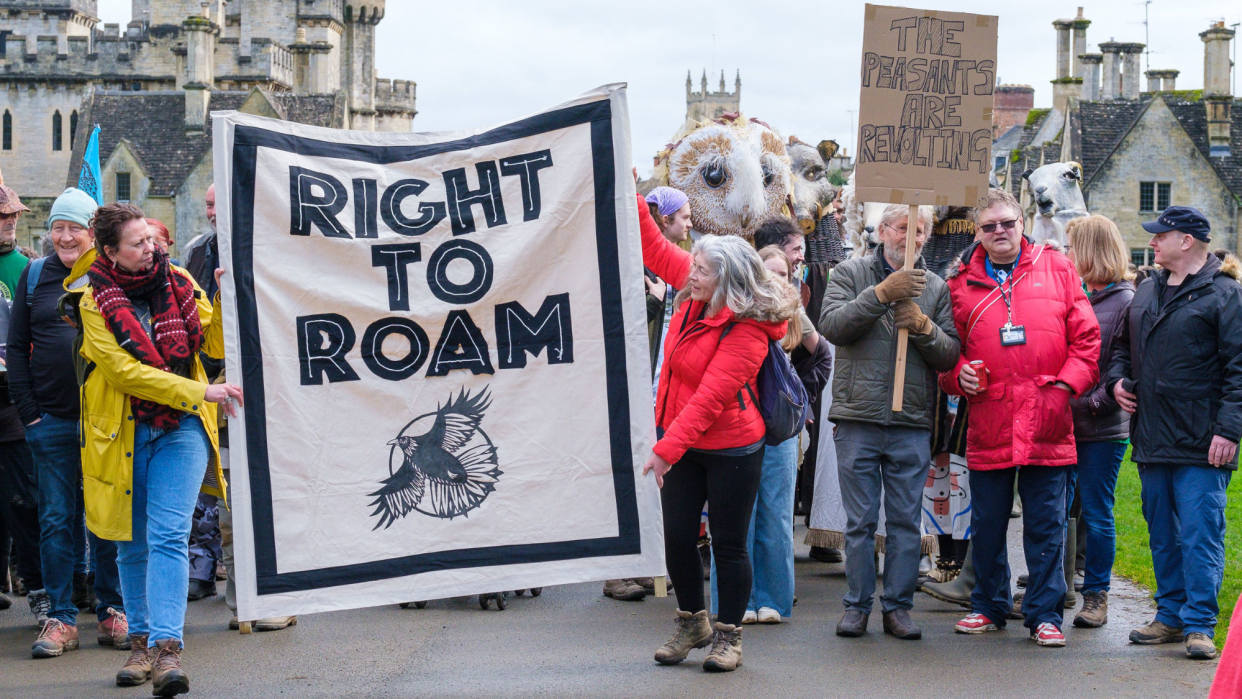Right to roam: the battle to access England's green spaces

In 2020, a Right to Roam campaign was founded by the writers Nick Hayes and Guy Shrubsole. Since then, it has organised a series of "mass trespasses": on Dartmoor, in Cumbria, on the South Downs; on the 12,000-acre Berkshire estate of Lord Benyon, who was at the time the minister responsible for access to the countryside.
At the most recent event, at Cirencester Park in Gloucestershire in March, more than 500 people marched in protest at plans by the Bathurst family, which owns the park, to impose an entry charge for the first time in more than 300 years. The campaigners argue that much more privately owned land in England should be open to the public, so that they can have "easy access to open space, and the physical, mental and spiritual health benefits that it brings".
How much access do we have now?
The public has "open access" to only about 8% of England's land: common land, national parks, land owned by the National Trust, coastline, and so on. It is estimated that the public only has uncontested access to about 3% of the length of England's nontidal rivers (they are often rented out to fishing clubs). This reflects the distribution of land ownership. In 2019, research found that half of England is owned by about 25,000 landowners – less than 1% of the population.
Great swathes are devoted to shooting. Even in England's ten national parks, much land is privately owned and off limits to walkers: about half of it, according to the Campaign for National Parks. In 2000, the New Labour government made an attempt to improve access to green spaces by passing the Countryside and Rights of Way (CRoW) Act.
Did the CRoW Act change much?
The law gave a right to roam, without sticking to footpaths, on designated uncultivated land – mountain, moorland, heathland and downland. It also ordered a review of public rights of way: there are 140,000 of miles of footpaths in England and Wales. The CRoW Act is, however, limited in scope: it specifically excludes woodland and riverbanks. England, Wales and Northern Ireland still do not have a broader right of the kind that exists in Scotland. In 2003, the Scottish parliament passed legislation conferring a "right of responsible access" that covers almost all of its landscape except private gardens, cultivated land (though field margins are permitted), industrial areas and the like. Such a right exists across much of northern Europe. In Austria it is known as wegefreiheit, in Finland, Norway and Sweden, allemansrätten, or "every man's right to nature".
Why should we have such a right?
The physical and mental health benefits of spending time outside are well documented. But one in eight British households doesn't have a garden, and according to a recent poll for Bupa, more than 52% of Britons do not have access to a public park or common within walking distance. Besides, about 10% of English farm revenue comes from tax subsidies, so the nation as a whole arguably ought to have some benefit.
Beyond these utilitarian arguments, though, campaigners argue that exposure to nature and the right to walk in it are fundamental rights, and that a new law would be a repossession of an ancient freedom. Much common land was appropriated by landowners by the enclosure acts of the 18th and 19th centuries. The right to walk in open country has been slowly reclaimed over more than a century.
What do landowners say?
The idea is unpopular among farmers and landowners. "With littering and dog attacks on livestock at an all-time high, and a public lack of understanding when it comes to the Countryside Code," said Farmers Weekly, "a right to roam could have serious implications." Dogs savaging livestock costs farmers in England and Wales some £2.4m a year. Human footfall, and that of dogs, causes environmental damage, notably the destruction of the nests of ground-nesting birds such as curlews.
Other critics have noted the dog excrement, barbecues and other litter left behind, and the gates left open, by visitors. Some ignore dangers from livestock and farm machinery; many believe they already have a right to roam, and think this allows them to walk, swim and camp anywhere. The cost of repairing damage falls on landowners. Additionally, in England and Wales, there is much less unused land than in Norway or Scotland. And people already have access to the 140,000 miles of footpaths in England and Wales, which, as the Country Land and Business Association points out, would stretch around the world five times.
Is a compromise possible?
Campaigners say the right to roam would be "contingent on adhering to a strict set of responsibilities" – teaching walkers about the Countryside Code, and training dog owners to control their animals. They argue that increased rights of access would improve people's understanding of the natural world, helping to ensure that they treat it with respect. There are some shared interests between the two sides. The rural economy needs visitors. Many farmers now have holiday lets, farm shops and the like.
What is likely to happen?
In May 2023, Labour pledged to introduce a Scottish-style right to roam in England and Wales if it won the next election, saying that it would "replace the default of exclusion with a default of access". Within six months, however, the party had U-turned on that pledge, warning of a need to "tread very carefully".
Even so, polls suggest that the public wants to see access to the countryside increased: almost two-thirds of Britons support a Scottish-style right to roam in England, according to YouGov; only 5% strongly oppose it. And the shadow environment secretary, Steve Reed, says he would be "astonished" if increased access to nature isn't in Labour's manifesto.

